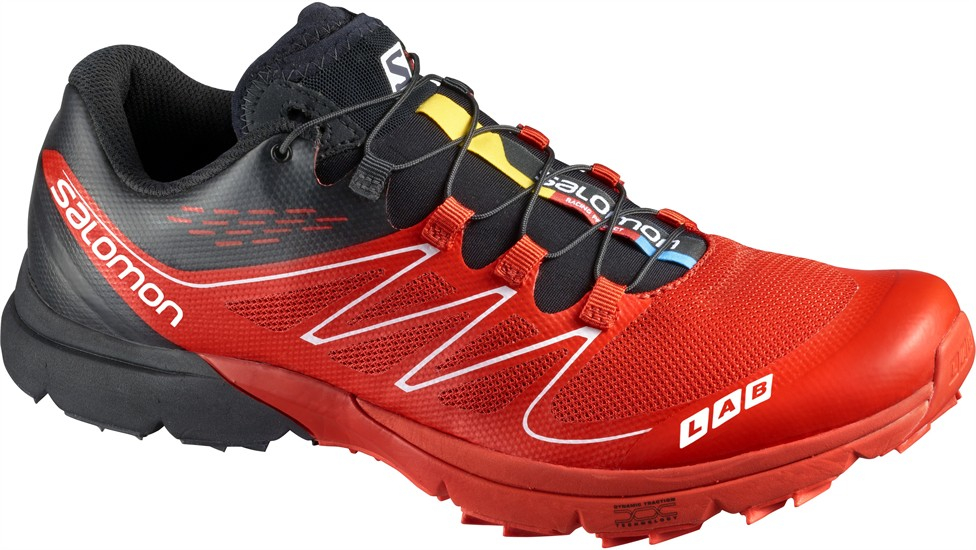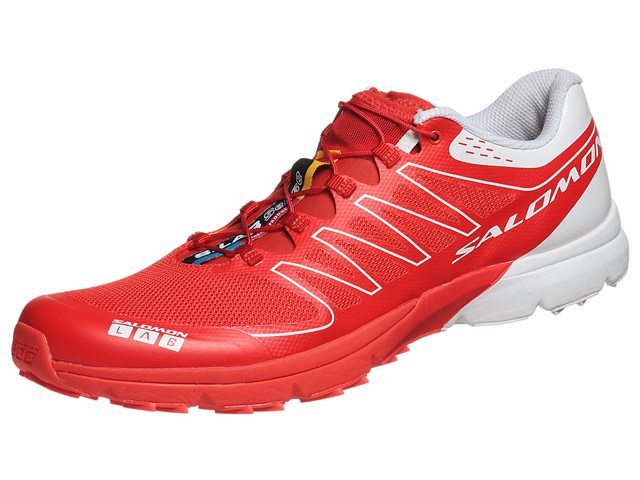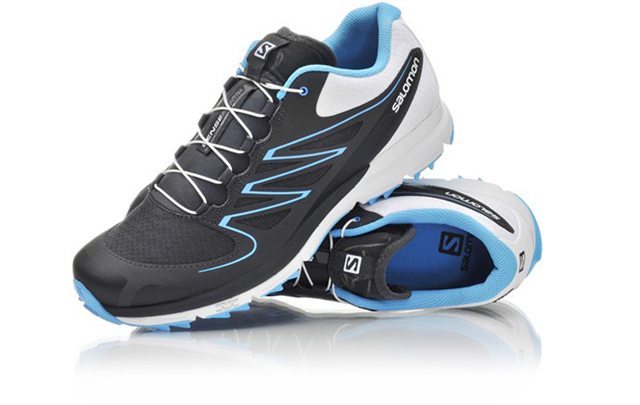Salomon S-Lab Sense Ultra

Size Tested: 10.5
• Blister’s Measured Weight Per Shoe:
221 grams / 7.8 ounces
Stated Stack Height & Drop:
Heel (13mm), Forefoot (9mm), Drop (4mm)
• Blister’s Measured Stack Height & Drop:
Heel (19mm), Forefoot (14mm), Drop 5mm
Available Width: D
Reviewer’s Feet: 278mm, D-width
Test Location: Utah’s Wasatch range
Conditions: Mostly dry and rocky. Lots of stream crossings and the occasional wet root and snow drift.
Test Duration: ~175 miles over 6 weeks of use
The S-Lab Sense Ultra is Salomon’s latest offering in the “Sense” family of lower-drop running shoes, and it puts a premium on reduced weight and heightened trail feel. Its firm, thin midsole with a low-drop design requires the runner to adapt to or adopt a forefoot / midfoot running style.
The S-Lab Sense Ultra is predated by the even lighter S-Lab Sense:

And the Salomon Sense Mantra was added this past year to compliment the S-Lab shoes by offering a more durable, all-around training shoe with a slightly greater drop (6mm) and greater weight (~270 grams per shoe):

The “S-Lab” designation that is applied to both the Sense and Sense Ultra indicates that Salomon considers these shoes to be true racing equipment—they are the exact shoes used by Salomon’s top level pros in international competition.
And the S-Lab designation is appropriate in my mind. These things are fast.
The Fit
I found the Sense Ultra to fit true to size, with the Ultra fitting nicely out of the box. I wear a 10.5 in most of my running shoes (including the Brooks Pure Grit and Merrell Trail Glove), with the New Balance MT110 being one of the few shoes I need to move up to a size 11.
I would describe the fit of the S-Lab Sense Ultra as follows:
• Heel: Snug / Low Volume (comparable to the Pure Grit and Trail Glove)
• Midfoot: Medium (comparable to the Pure Grit, narrower than the Trail Glove)
• Toebox: Narrow (fairly pointy compared to most shoes in this class)
• Arch Structure: Medium
The S-Lab Sense Ultra felt very nice right out of the box. The seamless construction is immediately familiar and comfortable, and the shoe moves very well just striding around and before being broken in.
(I do, however, have a very pronounced saddle bump on top of my instep, and did have a bit of problem getting into and out of the shoe. Salomon uses their Quicklace system on the Sense Ultra, and those laces do not allow the tongue to open wide enough for my fat foot. More on this later.)
The Sense Ultra has a very precise fit all the way through the foot. I had no issue with the pointy toe-box, and my toes splayed out without hindrance. But if you are accustomed to very wide, roomy toe boxes (e.g., the Altra Lone Peak and Merrell Trail Glove) you may want to try the Sense Ultra on before you buy.
Even with my wide foot, on trail, I liked the Sense Ultra’s pointy toe box, as I seemed less likely to snag a rock or root than when I’m running in more boxy shoes—roots and rocks seemed to just glance off when I happened to take a careless step.

Socks / Sockless
Since the fit of the Sense Ultra is snug, and its last is anatomically precise, I would strongly suggest going either sockless (not my cup of tea), or running in the thinnest socks you can find. And if for some reason you like thick socks, I would suggest trying on the shoe in a half size larger.
My First Few Runs
My first run in the Sense Ultra was a 14-miler with a nice mix of road, double track and technical singletrack. I had been running primarily in the more cushioned Brooks Pure Grit, but still logging occasional miles in my old New Balance MT110, which is fairly similar to the Sense Ultra—they both give minimal support, offer a lot of trail feel, and have a firm midsole.
I was not entirely prepared for how firm the Sense Ultra was, however, and unfortunately only made 12 of the 14 miles before having to walk the last two miles with a very sore LCL (Lateral Collateral Ligament) stemming from IT band tightness.
Of course, this is my own stupid fault for launching into a pretty long run in any pair of new shoes.
[Editor’s Note: This would be a good time to issue the reminder that, for anyone transitioning into more minimalist shoes, or moving into a different minimalist shoe, you would be very wise to ease into new situations. If you don’t and you experience pain or discomfort, don’t immediately blame the shoe, blame your lack of patience.]
This knee pain continued for the next eight runs and 40+ miles, generally springing up around 4 to 5 miles into the run. This pain was often accompanied by a slightly numb foot on the same leg. At this point I shelved the Sense Ultras for a few weeks and decided to go back to the Pure Grit…
But because Utah’s high alpine was rapidly drying out, and since backcountry trails can be more forgiving on imperfect form, I felt an increased level of security in trying out the Sense Ultras again.
Round 2 in the S-Lab Sense Ultra
For my first run back in the Sense Ultra, I decided to remove the Quicklace system and just use regular laces to increase the ease of entry into the shoe. Plus, I had noticed that the quicklaces slid very easily in the eyelets of the shoes, so unless I pulled them very very tight, my foot would slide around inside the shoe.
So snip-snip, thread-thread, and normal shoe laces were installed.
My first run back in the Sense Ultra (now with regular laces that weren’t overtightened) was up the trail I run 4 to 5 days a week. And BANG. Heaven. So happy. Pure running bliss.
This was my fastest and most efficient 7.5 mile, 2000 vertical foot run of the spring. I was able to hold a consistently faster average pace than usual, and I still feel fresh at the finish.
Upon reflection, I had been pulling the Quicklaces too tight to prevent foot slide, but doing so was restricting my ability to fully splay my foot. This caused mild numbing in the toes, and prevented my foot from adequately cushioning the step. In short, overtightening those laces appears to have been a major factor behind my knee pain.
I have put more than 100 miles in the Sense Ultra since this epiphany, and I have consistently held the same “personal best” pace on all of these runs. For me and my running style, these shoes really are fast, and the S-Lab “competition” classification feels legit. You are paying for speed. The Sense Ultra is simply a very nice blending of subtle improvements that all add up to a significant performance increase.

Is there anyone out there who actually likes speed laces?
They seem to be the answer to a question that only triathletes ever asked.
Most long-distance runners will attest that their feet expand after running considerable miles. A lacing that felt supportive before the race started will often feel to tight at mile 30, at least for me. Making a minor adjustment to the lacing tightness by using speed-laces is much quicker than untying my whole shoe and retying it from scratch. This is the reason why many ultra runners even fit speed-laces to their non-Salomon shoes.
thanks for the comment!
i totally agree its a very personal thing on those laces. i have had no issue needing to re-lace/re-tie at the 50k distance, but I’m not super ultra beyond that.
my gripe with speed laces is more a fit issue. i have a very wide forefoot and a very low volume instep and heel, so i run with almost no lace pressure across the toes and max tightness on the upper 2 lace holes. with “speed-setups”, where the lace is very thin and smooth, the shoe naturally pulls even tension across the whole foot, and that leads to fore-foot cramping and a lifting heel for me. i like a little friction in the laces at the lace-holes so that i can run the laces with the appropriate tension at different places on my foot.
all the best
Were this tested with the stock insoles (which roughly resemble wet paper) or something else? I almost always slip Superfeet or similar in my trail runners, BUT obviously didn’t in something a NB Minimus. These seem to be a little in between. I’ve done one run in my Sense 2s with green Superfeet from another shoe and they were fine, but certainly had an impact on the fit. Obviously, it’s personal preference, but was just curious what others were doing.
I noticed my achilles agitated after my initial run in these shoes. I’ve run in 4mm drop shoes so I didn’t exactly think that would be the reason. I also have a full volume foot also and was curious about what you said with the speed laces. Do you think for any reason that removing the speed laces may alleviate the achilles thing? It feels like my foot is locked in such a way that the tendon is forced and can’t flex like it should. If that’s not the issue I’d rather not do it and risk not being able to return them. Curious if may have any feedback as it seems that you had some initial issues, also.
Thanks!
hi michael, if you are over-tight on the forefoot, i could see that causing *some* problem by over compensating somewhere else in the foot/leg.
cutting the pull tab worked for me, for sure, but its a one-way process… hard to “recommend” per se, but i had great results when i did. if you do, i hope it works well!
sorry if that is not more helpful?
I just bought a pair of Solomon trail shoes and wanted to replace the quick laces with regular laces to prevent heel slippage, but the eyelet holes seem so small. When I called Solomon to ask if there were regular laces that would fit they said they didn’t know of any. What kind of laces did you use?